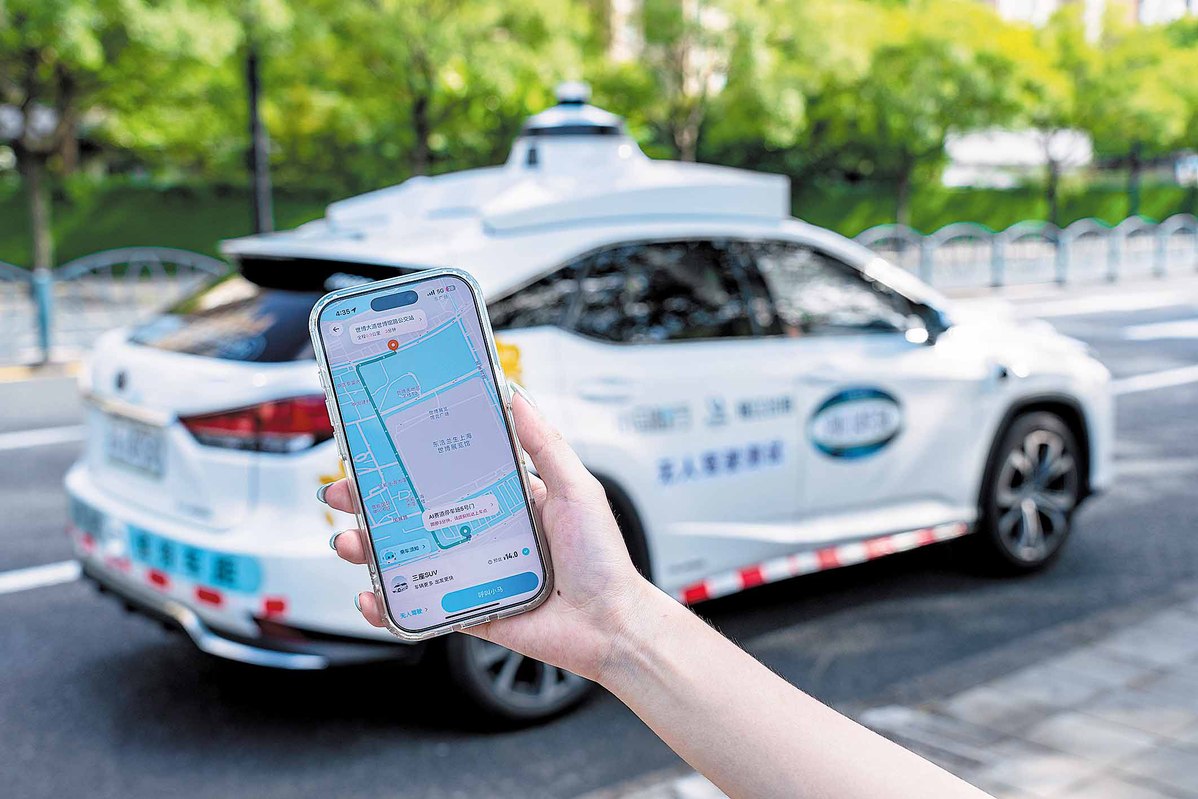Shanghai 'model' sets pace for robotaxi services
City pilots driverless commercial operations in densely populated business zone


Years of preparation
As the Chinese saying goes, "constant dripping wears away the stone". The recent rollout of autonomous driving projects in Shanghai is the result of years of preparation.
Huang, vice-president of Pony.ai, said the company began exploring new ways to integrate self-driving technology into traditional taxis in 2022, partnering with Jin Jiang taxi.
In 2023, the two companies jointly received demonstration permits from the city and launched a pilot autonomous taxi service in Jiading district.
Shi, from Jin Jiang's taxi service arm, said: "Over the years, we have explored various cooperation models with partners. The autonomous vehicle sector is still in its early stages. While many companies may enter the race, only a few are likely to remain long-term."
Dazhong Transportation's Ge said the company first entered the autonomous driving field in 2021, exploring partnerships with several tech firms, including Baidu.
"Eventually, we established a deeper collaboration with Baidu, signing a strategic cooperation agreement in October 2022 after both sides confirmed mutual alignment," he said.
In the past two years, autonomous and intelligent driving technologies have advanced rapidly, and experts believe the industry is approaching a key takeoff point.
"Apart from the technology leap, the rise of new-energy and smart vehicles has boosted consumer awareness of intelligent mobility in China, which means on the demand side, people increasingly believe that technology can deliver real convenience," said Fang from McKinsey.
Fang said the intelligent mobility sector is a large ecosystem involving hardware firms, tech companies, automakers, and operators. Years of industry development have strengthened each player's capabilities, creating the conditions to accelerate the sector's growth.
Nationwide expansion
Derek Hong is a 32-year-old compliance chief at a multinational crypto assets company in Hong Kong.
On Aug 15, he experienced a 10-km robotaxi ride provided by Pony.ai during a business visit to Nansha district in Guangzhou, Guangdong province.
"The whole ride was smooth and steady. You hardly noticed it (the vehicle) was driverless," Hong said. "The in-car screen clearly detected motorcycles, pedestrians, and bicycles. It felt impressive."
He added he had heard about robotaxi trials in a closed area of Hong Kong's New Territories and was eager to try them if given the chance.
Robotaxi services have already expanded across multiple cities in China. Pony.ai, for example, launched the country's first autonomous ride service in Guangzhou in December 2018, initially with safety operators and free rides. In May 2020, the service started in Beijing, followed by Shanghai in July 2021 and Shenzhen in May 2022.
By the second half of 2023, fully driverless commercial operations began in several cities.
In August 2023, fully autonomous rides offered by Pony.ai were approved in Beijing. In December 2023, Nansha district approved the first driverless commercial mixed-traffic trial; in January 2024, Shenzhen's Bao'an district granted a commercial pilot license; and by July 2025, Shanghai issued its first demonstration permit for intelligent connected vehicles.
In a May report on China's robotaxi market, Goldman Sachs estimated the country's Robotaxi TAM (Total Addressable Market) would reach $47 billion by 2035 versus $54 million in 2025, with the driving forces including decreasing costs of hardware and algorithms, and lower operating costs for fleet owners.
"By 2035, we expect revenues per robotaxi in first-tier cities to reach $31,000, higher than current ride-hailing vehicles, due to longer operating hours and efficient route planning," said the report.
Fang said China's robotaxi development is likely leading the world, and has benefited from advances in smart and electric vehicles. Autonomous driving relies on deep-learning AI, and China's vast and diverse market — with varied scenarios and regions — provides a rich environment for training and refining algorithms, which makes the country particularly well-suited for accelerating autonomous driving technology.
"From a safety perspective, autonomous vehicles have a relatively low accident rate. Unlike human drivers, who can experience fatigue or be in a bad mood, self-driving systems remain consistent," said Shi.
Insurance data from the latest coverage for driverless vehicles also reflects confidence in the technology, with premiums lower than those for traditional cars, he said.
"From a business standpoint, full automation could reduce labor costs in the future. While the technology may temporarily affect drivers in the industry, it is also expected to create new roles, such as back-end monitoring staff and safety operators," Shi added.
























